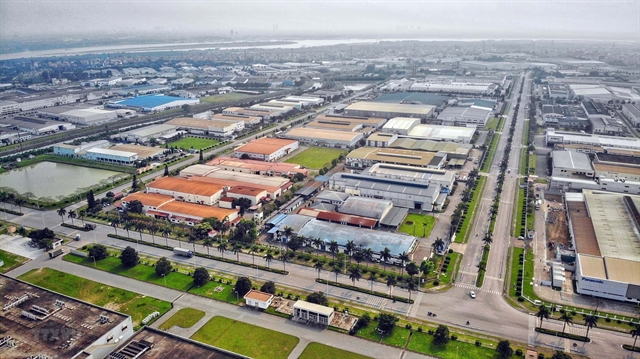
HÀ NỘI — Several large-scale industrial zones were being set up from the beginning of this year to capture the opportunity of attracting both foreign and domestic manufacturers in the wave of post-pandemic production and business recovery.
VSIP Group, at the end of March, started the construction of the VSIP 3 Industrial Zone, which covered more than 1,000 hectares in Hội Nghĩa Commune, Tân Uyên Town and Tân Lập Commune, Bắc Tân Uyên District, Bình Dương Province
To date, the industrial zone attracted more than 30 companies, both domestic and foreign, to study the production opportunity, with an expected total investment of around US$1.8 billion.
Recently, the Đại An Urban – Industrial Zone Development Corporation Joint Stock Company and Indian partners signed a cooperation agreement for developing a 960-hectare pharmaceutical park project worth around $10-12 billion in Hải Dương Province.
The park was expected to be where famous pharmaceutical companies in the world gathered for research and production.
Saigon Telecom Technology Joint Stock Company (Saigontel) and VinaCapital signed a memorandum of understanding with Singapore – based Aurous about cooperation in investing in a 700-ha urban–industry complex in Bắc Giang with an estimated investment of around $2.5 billion.
According to SSI Research, the demand for hiring industrial land will be strong this year, fuelled by a production shift to Việt Nam together with the completion of infrastructure projects such as Biên Hòa – Vũng Tàu, Dầu Giây – Phan Thiết, North-South expressways, Thị Vải – Cái Mép and Gemalink ports.
SSI Research forecast that industrial land rents in Việt Nam would increase by 8-9 per cent in the Southern region and 6-8 per cent in the North this year due to a scarcity of supply amid the rising demand.
Sử Ngọc Khương, senior director of Savills Việt Nam, said that the positive growth prospect of the Vietnamese economy after the pandemic attracted investors and created conditions for the industrial real estate market to be robust in the first months of this year.
To attract multinational corporations, Việt Nam needed to develop not only large-scale industrial parks but also the transportation and logistics infrastructure systems and hasten administrative reforms to improve the investment climate, Khương said.
Localities and Vietnamese firms need to prepare high-quality human resources, especially for hi-tech industries, to meet the demand of multinational corporations, an important factor to attract them, as the Government prioritises attracting investment in hi-tech industries, not labour-intensive.
According to David Jackson, CEO of Colliers Việt Nam, Việt Nam needed to renew the industrial park development model to build eco-industrial parks.
This model would play an important role in the sustainable development strategy, reducing resource exploitation and limiting the impact on the environment but not affecting the performance of businesses, adding that this model would also contribute to the countries and global effort to combat climate change.
Specific steps to be taken were to improve the technology transfer capacity of enterprises, apply advanced technologies and minimise emissions, he added.
He said that industrial zones should enhance linkage to develop production and logistics chains to improve competitiveness, lower production costs and increase sustainability. — VNS
- Reduce Hair Loss with PURA D’OR Gold Label Shampoo
- Castor Oil Has Made a “Huge” Difference With Hair and Brow Growth
- Excessive hair loss in men: Signs of illness that cannot be subjective
- Dịch Vụ SEO Website ở Los Angeles, CA: đưa trang web doanh nghiệp bạn lên top Google
- Nails Salon Sierra Madre
 VnExpress News The News Gateway of Vietnam
VnExpress News The News Gateway of Vietnam




